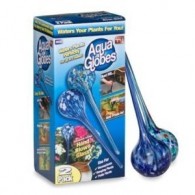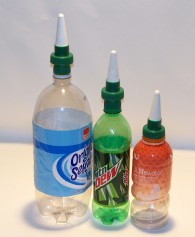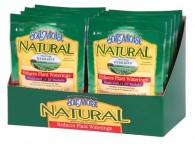Help, it’s hot as hell, and my plants need water… and I want to go away to the beach this weekend, what can I do?
Brooklyn Grows with Kimberly Sevilla
 Yup, it’s hot, and when it’s hot, we perspire, and plants transpire. The key to successful gardening is keeping our plants well hydrated, and there are several ways we can achieve this without the need to water them every day; this includes self-watering planters, plant sitters, soil engineering, additives and drip irrigation systems.
Yup, it’s hot, and when it’s hot, we perspire, and plants transpire. The key to successful gardening is keeping our plants well hydrated, and there are several ways we can achieve this without the need to water them every day; this includes self-watering planters, plant sitters, soil engineering, additives and drip irrigation systems.
If you are planning a trip out of town, be sure that your plants will get the water they need. The simplest way is to get a large container, like a kiddy pool and put your plants in the pool and fill it up to about 3 inches. I know you’ve been told not to let plants sit in water, but over a long weekend, they will be fine. Be sure to take them out when you get home. This will protect your plants while you are away. For houseplants, you can use your bathtub or sink as a plant sitter, just be sure that the plants are still getting plenty of light.
 An alternative to this, is to place a bucket of water near your plants and to use a cotton cord (a clothesline works great). Place one end of the the cord through the bottom of your container into the soil, and the other end into the bucket of water. The water will wick through to your soil from the pot, this works because of osmosis; isn’t science fun?
An alternative to this, is to place a bucket of water near your plants and to use a cotton cord (a clothesline works great). Place one end of the the cord through the bottom of your container into the soil, and the other end into the bucket of water. The water will wick through to your soil from the pot, this works because of osmosis; isn’t science fun?
There are many self-watering planters on the market, my favorite is the Earthbox. We have been using ours for a few years now and it’s terrific for small patios. I have never had a problem with my plants and my tomatoes grow to be HUGE in the box. I love the fact that it’s on wheels and can be moved around our patio. There are also a number of self watering window boxes available. Misco, makes an especially nice one that is made right here in New York from recycled plastic, I call this good plastic. You can also make your own out of five gallon buckets. Some great instructions can be found at: www.sustainlane.com.
Plant sitters are nifty devices that hold water and are placed in the soil. Those “as seen on TV globes” actually work, and even look pretty. Other alternatives: plastic soda bottles or wine bottles.
For plants in the garden (and in pots), be sure to add lots of organic components to your soil at the time you are planting; this can include compost, manure, leaf mold, coir fiber, cocoa shells, whatever, and be sure to mulch up to 3 inches. The mulch will hold in moisture and will keep your plants’ roots cool. The organic components will hold in extra moisture and release it back to your plants when they need it. Make sure you use organic fertilizers; chemical fertilizers will kill microorganisms in the soil that help break down organic components which allow the plants to get the nutrients they need. Chemical fertilizers also bind up trace elements and make your soil silty and dry.
Soil Moist Natural is another product that will help save your plants. Soil Moist is a starch that is designed to help reduce plant watering. It holds several hundred times its weight in water and releases back to the plant as the soil dries out. I use this in hanging baskets and containers as well as in guerilla gardens in tree pits to help keep the plants alive. People have suggested using rice to me, I haven’t tried it, if you do, let me know if it works.
Another terrific method for keeping your plants hydrated is to install a drip irrigation system. The drip irrigation systems are low flow systems that deliver water slowly next to the roots. You can use this system in conjunction with an automatic timer or with a countdown timer that shuts off after it is set. Dripworks.com has lots of kits that come with all sorts of emitters, hoses, and sprayers that you can use. If you like to tinker, putting it together can be a lot of fun. The initial cost is somewhat daunting, about $200 for a small city garden, but after it is all set up you get to enjoy your plants with no worries and spend your time doing other things, like cooking all the terrific food you grew.
What can I plant now from seed?You can plant a lot of things now from seed, just check the packet. Our first frost date is around Halloween, fast maturing plants like lettuce and radish can be sewn up to that date. Longer growing plants like pumpkin, squash and corn can also be planted now, we still have about 100 days left in the growing season before the first frost, so you can plan on a harvest by then if the days to maturity is 100 days or less. The trick though is to keep the seeds moist and the seedings hydrated. Use cheesecloth or a row cover if you plant seeds outside to protect them from the sun. Use misters, drip emitters or a soaker hose on your seedbed to keep the seedlings moist.
Will summer bulbs grow if I plant them now?Yes. summer bulbs such as lilies, dahlias, and gladiolus will bloom if planted now and you can take advantage of the summer sales. They all love containers. It’s also a great use of space that may have been freed up by plants dying from lack of water (oops) or from removing spring crops like radish and lettuce that are too far gone to eat. Just remember to use bone meal or an organic fertilizer and mulch.
Kimberly Sevilla,
Rose Red & Lavender
653 Metropolitan Ave, Williamsburg

Leave a Reply